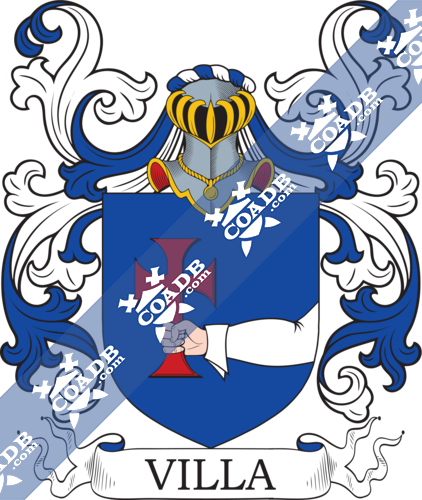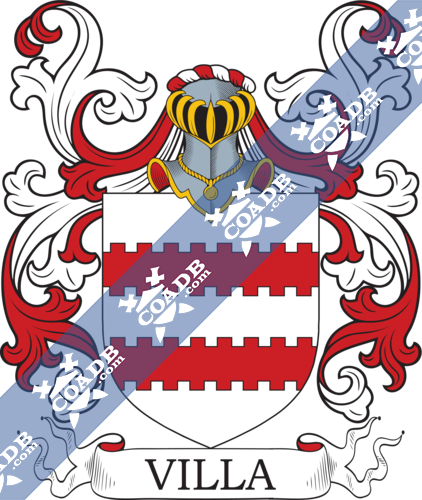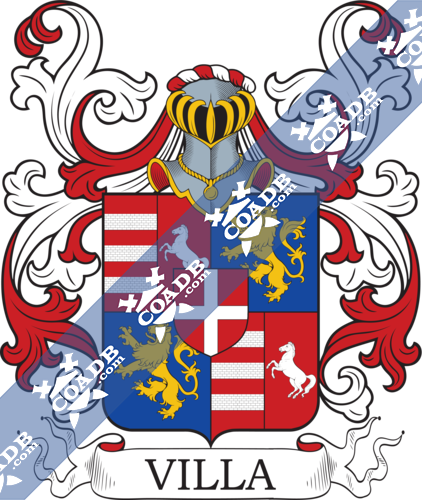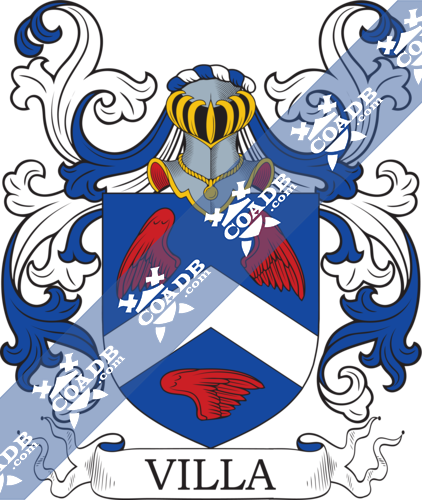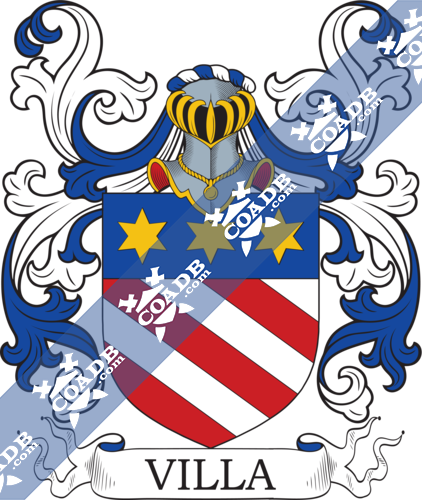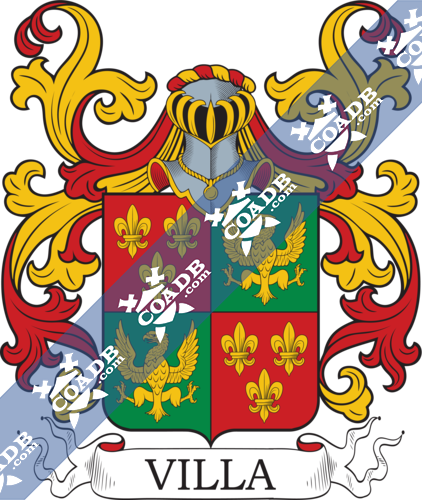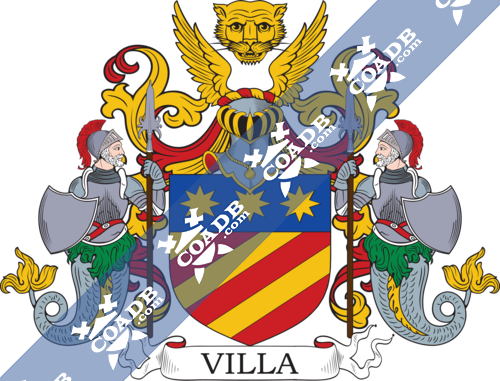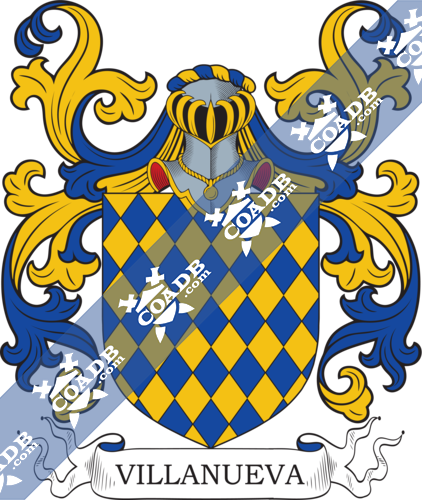Villa Family Crest, Coat of Arms and Name History
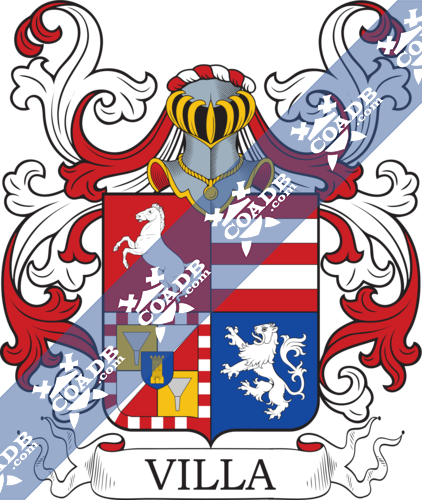
Villa Coat of Arms Gallery
Don’t know which Coat of Arms is yours?
We can do a genealogical research. Find out the exact history of your family!
Learn MoreSurname Meaning, Origin, and Etymology
Locational surnames were very popular in Medieval Europe. They were derived from the name of a city or a place with a particular feature. The Spanish surname Villa is among this category of last names because it comes from the Latin word “villa” which means village. This surname was given to someone who used to live in the central area of a village, not to those who lived on the outskirts of the urban center. During this time, there were some places named Villa, Vila or Vile in Europe, and people from those places used to also bear the surname Villa.
The history of Villa can be traced back to the days of the Roman Empire, especially to the territory that is France today. It then passed to England, thanks to the Norman Conquest in 1066, just like many other surnames that then became very common in all Britain. The oldest record of a bearer of this surname belongs to Jaime Vila, who was a witness for a baptism in Tenerife in the Bearlic Islands on February 11th, 1575.
Spelling Variations
Just like any other surname, Villa counts on its own portion of spelling variation. But before we jump into them, it is important to know why this phenomenon occurred. The big movements of people were not rare in Medieval times and with them, different cultures had an impact on a society. This happened after a war, when the rulers changed, so the new ones imposed their costumes and traditions over the conquered ones. This caused that a single group of people was influenced by different cultures, and part of that influence was in the surnames because the victorious could use their surnames over the defeated.
Another reason was the lack of grammatical rules and the illiteracy. These two aspects worked together to create spelling variations on surnames. The lack of writing rules caused that he wasn’t a right way of writing, there wasn’t a guide to tell what was right or wrong, so everyone could do it differently. Actually, during this time of history, only the scribes executed the task of keeping a written record of things, because they were the only ones that knew how to write. But, with the lack of grammatical rules, they only base they had to know how to write words was how they sound, which meant that every scribe wrote the same word in different ways.
The third reason for spelling variations on surnames was that certain familiar groups used to do some changes in their surnames to express an idea, such as to which king or lord they were loyal or which religion they followed. They did this by adding or removing some letters of the surname. Wrong translations also had a key role in this situation.
With all of this in mind, the most common spelling variations of Villa were D´Avilla, Da Villa, D´Avila, Devilla, Davilla, De Villa, Avila, Avilla, Ville, de Ville, de Villier, Desvilles, Vila, Vilas, Villabaso, Villeta and many more.
Popularity & Geographic Distribution
The surname Villa is the 1,081st most common surname in the world and it counts on approximately 490,214 bearers. The country where it is most relevant is in Mexico followed by Colombia and the Philippines, and it highest density is in Colombia. This data is taken from the census of 2014.
Early Bearers of the Surname
There are only two records of old bearers of Villa, they were Antonio de Villa Real de Valladolid on April 12th, 1579 and Pedro Villa de Cox in Alicante on June 20th, 1700.
History, Genealogy, and Ancestry
Unfortunately, there are no many records that describe the genealogical trees of families that bear the surname Villa, and the ones that we could find for this job are very short. There is one that began with Sebastian Villa who got married to Maria Elizabeth Baier Gomez, daughter of Carlos Baier Oviedo and Fresia Gomez Castillo. Sebastian and Maria had seven children, they were Elizabeth Teresa Villa Baier, Sergio Villa Baier who became a chemistry professor and got married to Claudia Cañete, Celso Villa Baier who became an engineer and got married to Georgina Gutierrez, Ingrid Villa Baier who became an English teacher and got married to man which last name was Orellana and had two children Johana Orellana Villa and Rocío Orellana Villa. The other children of Sebastian and Maria were Jacqueline Villa Baier Oscar Villanueva who got married to, Sandra Villa Baier and Katty Villa Baier.
Another genealogical tree that we could find belong a spelling variation of Villa and it started with Fernando Vila. Fernando was born in Galicia, Spain and got married to Mercedes Maturana Vergara, daughter of Gaspar Javier Maturana y Contreras and Micaela de Vergara y Toro Mazote, in 1799. They had one child Miguel Vila Maturana, who got married to Josefa Pizarro Silva, daughter of Jacinto Pizarro de la Jara and Micaela Silva Maturana. Miguel and Josefa had one child Juan Vila Pizarro who got married to Clara Silva Labra daughter of José Silva Pizarro and Micaela Labra Villalobos. Juan and Clara had only one child Francisco Antonio Vila Silva.
A third branch that we can study is the one of Angel Vila Rivera who got married to Victoria Elena de la Cruz Arend, daughter of Demetrio de la Cruz Cruz and Ana Ema Cornelia Arend Ellwanger. Angel and Victoria Elena had four children: German Vila de la Cruz who was born on April 18, 1936, Nelly Vila de la Cruz who was born on September 30, 1937, Patricia Vila de la Cruz who was born on November 23, 1949, and Oscar Vila de la Cruz who was born on December 30, 1952.
Early American and New World Settlers
There are some few records that allow knowing the first Europeans bearers of Villa in arriving in America. During the 19th century, these following users of Villa arrived at the United States: Franca Villa in 1826, Rafaelo Villa who arrived in 1831, Franco Villa who did it in 1836 and Pedro Villa who arrived in 1846. At the new century, this arrival continued with Adelina Villa, in 1912, Adalgisa Villa in 1941, Albina Villa who did it in 1926, Aime Villa who arrived in 1923 and Aguilino Villa who arrived in 1924.
Mottoes
Mottoes were a slogan that families used to employ to express something about themselves, like their code of honor, or the religion. They were so important that it was almost mandatory for a noble family to have one. In the case of the surname Villa, the motto was “una buena muerte honra toda una vida”, which means “a good death honors the whole life”.
Notables
There have been some bearers of Villa that have played important roles in different fields such as Javier Villa (b. 1987) a racing driver from Spain, David Villa (b. 1981) a Spanish football soccer player, Marco Villa (b. 1969) an Italian Olympic cyclist, Emmanuelle Villa an Argentinian football soccer player, Jose Moreno Villa an Spanish poet, Regina Villa an American politician and Amparo Villa, another American politician.
Blazons & Genealogy Notes
1) Piémont – Écartelé aux 1 et 4 de gueules à un cheval cablé d’argent au 2 de gueules à deux fasces d’argent au 3 contre-écartelé d’or à un entonnoir au naturel et d’un taillé d’argent sur gueules avec un surtout sur ces quartiers d’azur à une tour d’or et une bordure componnée d’argent et de gueules au 4 d’azur au lion d’argent
2) Trévise – Écartelé aux 1 et 4 de gueules à un cheval cablé d’argent au 2 de gueules à deux fasces d’argent au 3 contre-écartelé d’or à un entonnoir au naturel et d’un taillé d’argent sur gueules avec un surtout sur ces quartiers d’azur à une tour d’or et une bordure componnée d’argent et de gueules au 4 d’azur au lion d’argent
3) Vérone – D’azur à un avant-bras paré d’argent mouvant du flanc senestre tenant une croix latine pattée de gueules
4) Comtes de Villastellone – Piémont – D’argent à deux fasces bretessées de gueules
5) Ferrare – (Comtes de Monte-Obizo et de Camerano, marquis de Ciliano, de Volpiano et de Settimo, vicomtes de la Stella, barons de la Costa di San-Andrea, etc) – Barré d’or et de gueules au chef d’azur ch de trois étoiles (8) d’or Cimier une tête de léopard d’or entre un vol du même Tenants deux chevaliers armés de toutes pièces la visière levée le casque panaché de gueules le corps terminé en queue de poisson tenant chacun une pique Devise DROIT EN AVANT
6) Padoue – Écartelé aux 1 et 4 parti a de gueules à trois fasces écaillées d’argent b de gueules à un cheval cabré d’argent aux 2 et 3 d’azur au lion d’or Sur le tout de Savoie qui est de gueules à la croix d’argent
7) Padoue – D’azur au chevron d’argent acc de trois demi-vols de gueules les deux du chef abaissés et affrontés celui en pointe posé en fasce le dossier à dextre
8) de Moros – De gueules à un Sarrasin posé de front coiffé d’un turban d’argent habillé d’une veste et d’un haut-de-chausses jaunes et d’un surtout de sable les pieds nus chaussés de pantouffles de gueules ledit Sarrasin attaché par le col à une chaîne de sable mouvant du canton senestre du chef. English: Gules with a Saracen placed facing forwards wearing on the head a turban argent dressed in a coat and high trousers of yellow and a sleeveless overcoat [surtout] sable the feet bare in slippers gules the aforesaid Saracen attached by the shoulder to a chain sable coming from quarter sinister of the chief.

